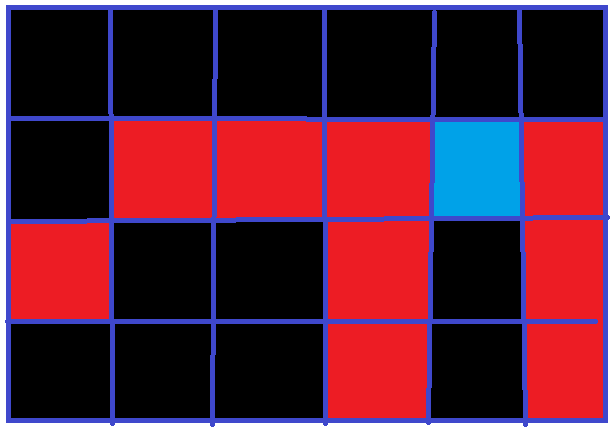红与黑
题解
说明
其实这里考查的是Flood Fill算法(洪水灌溉算法)
Flood Fill 分为两种
- bfs :可顺便求出最短距离
- dfs : 更为方便,但是题目不严谨时,可能会爆栈
- 题目草图
蓝色表示现在的位置,只可以走黑色,不可以走红色,求可以到达的黑色色块数量。

解法一:宽度搜索优先遍历
思路
1、先定义上下左右四个方向
2、对周围格子进行遍历,然后进入符合的格子
3、循环往复,直到全部格子都被遍历
代码
#include<iostream>
#include<cstring>
#include<queue>
using namespace std;
typedef pair<int,int> PII;
const int N = 22;
char diban[N][N];
int n,m;
bool st[N][N];
int cnt;
//宽搜
int bfs(int x,int y)//将初始位置输入
{
queue<PII> que;
que.push({x,y});
st[x][y] = true;
cnt++;
//四个方向逐一遍历,上、下、左、右
int dx[4] = {-1 , 1 , 0 , 0} , dy[4] = { 0 , 0 , -1 , 1};
while(que.size())
{
//这个位置已经遍历过了,那么取出来
PII q = que.front();
int qx = q.first , qy = q.second;
que.pop();
int tx = 0 , ty = 0;
//四个方向进行行走
for(int i = 0 ; i<4 ; i++)
{
tx = qx + dx[i] , ty = qy + dy[i];
//判断是否合理,一是有没有走过,二是符不符合灌溉条件
if(diban[tx][ty] == '.' && !st[tx][ty] ) //符合
{
//进行灌溉
que.push({tx,ty});
st[tx][ty] = true;
cnt++;
}
}
}
return cnt;
}
int main()
{
while(cin >> m >> n, n || m)
{
//一切清零,重新开始
cnt = 0;//数量清零
memset(st , false , sizeof st);
int x = 0, y = 0;//初始位置
//输入
for(int i = 0 ; i<n ; i++)
for(int j = 0 ; j<m ; j++)
{
cin>>diban[i][j];
if(diban[i][j] == '@')
{
x = i ;
y = j ;
}
}
cout<<bfs(x,y)<<endl;
}
return 0;
}
解法二:深度搜索优先遍历
思路
1、先进行一个方向的遍历
2、然后不可以在这个方向进行遍历了,那么换一个方向进行遍历
3、直到所有方向都不能进行遍历,那么回溯到上一个格子
4、全部格子都被遍历,那么结束
代码
#include<iostream>
#include<cstring>
using namespace std;
const int N = 22;
char diban[N][N];
int n,m;
bool st[N][N];
int cnt;
//深搜
void dfs(int x,int y)
{
cnt++;
//按上、左、下、右,顺序遍历节点
int dx[] = {-1 , 0 , 1 , 0} , dy[] = { 0 , 1 , 0 , -1};
//深度搜索
for(int i = 0 ; i<4 ; i++)
{
int tx = x + dx[i] , ty = y + dy[i];
if(diban[tx][ty] == '.' && !st[tx][ty] )
{
st[tx][ty] = true;
dfs(tx,ty);
}
}
}
int main()
{
while(cin>>m>>n, n || m)
{
//一切清零
cnt = 0;
memset(st , false , sizeof st);
//初始位置
int x = 0 , y = 0;
for(int i = 0 ; i<n ; i++ )
for(int j = 0 ; j<m ; j++)
{
cin>>diban[i][j];
if(diban[i][j] == '@')
x = i , y = j;
}
dfs(x, y);
cout<<cnt<<endl;
}
return 0;
}

